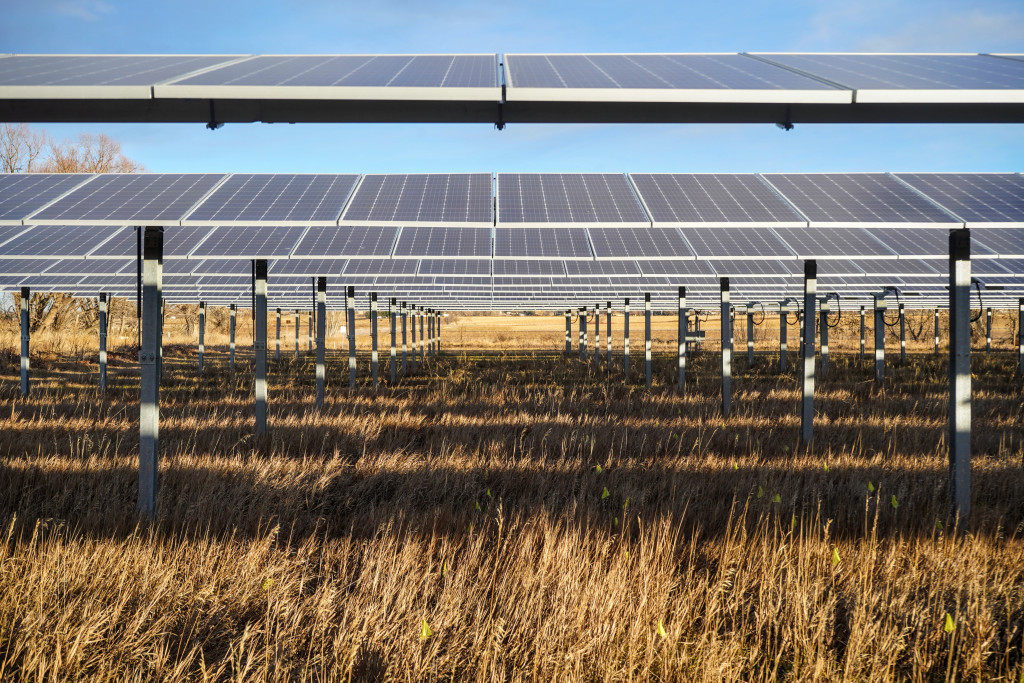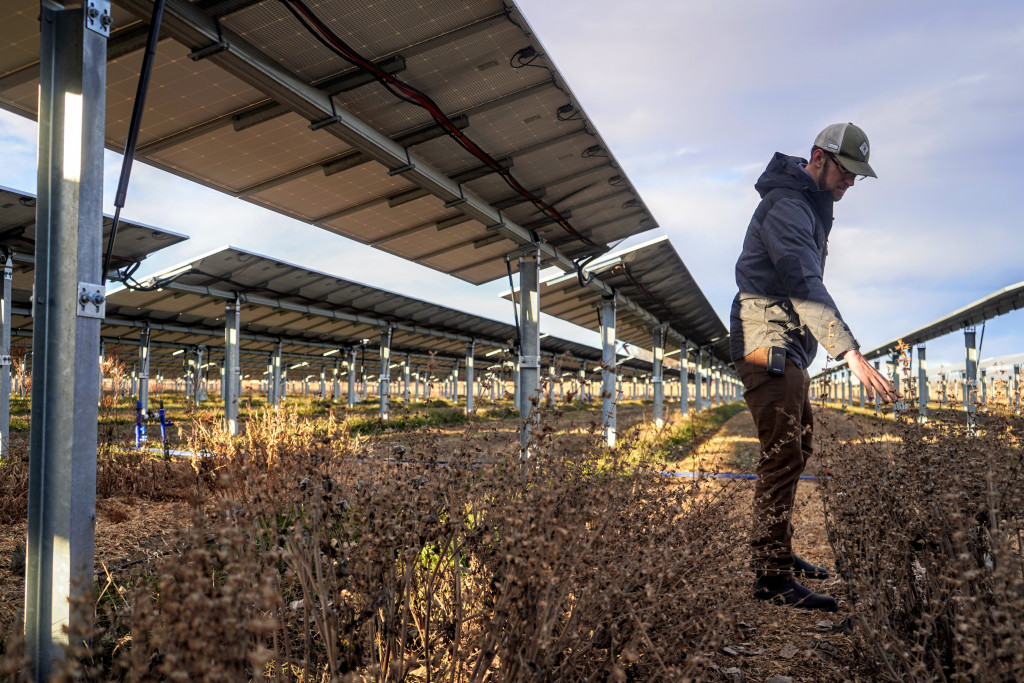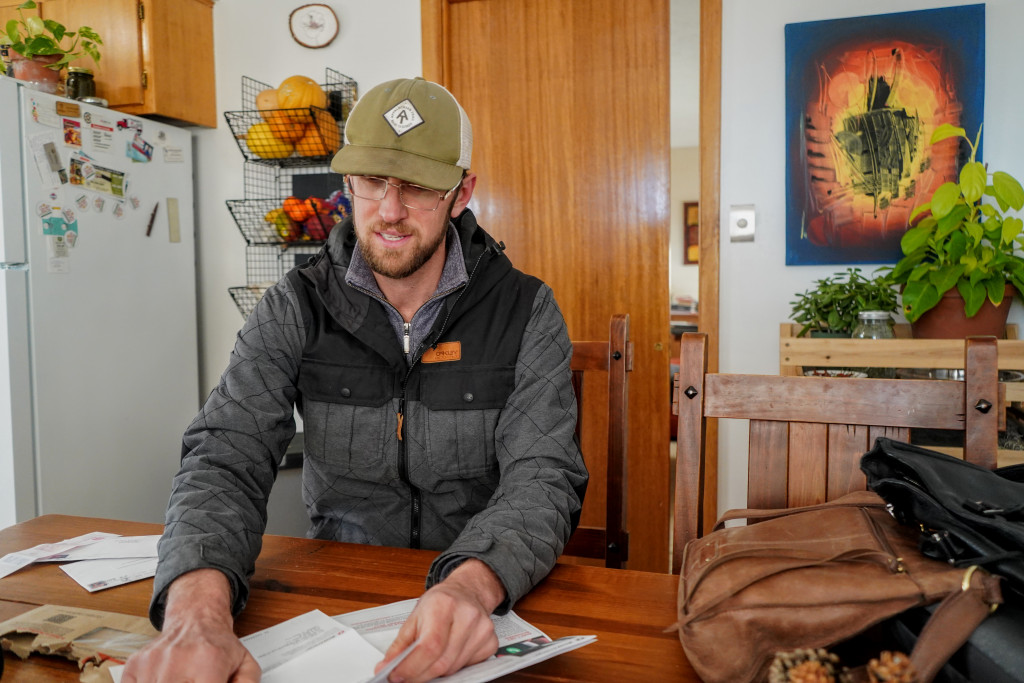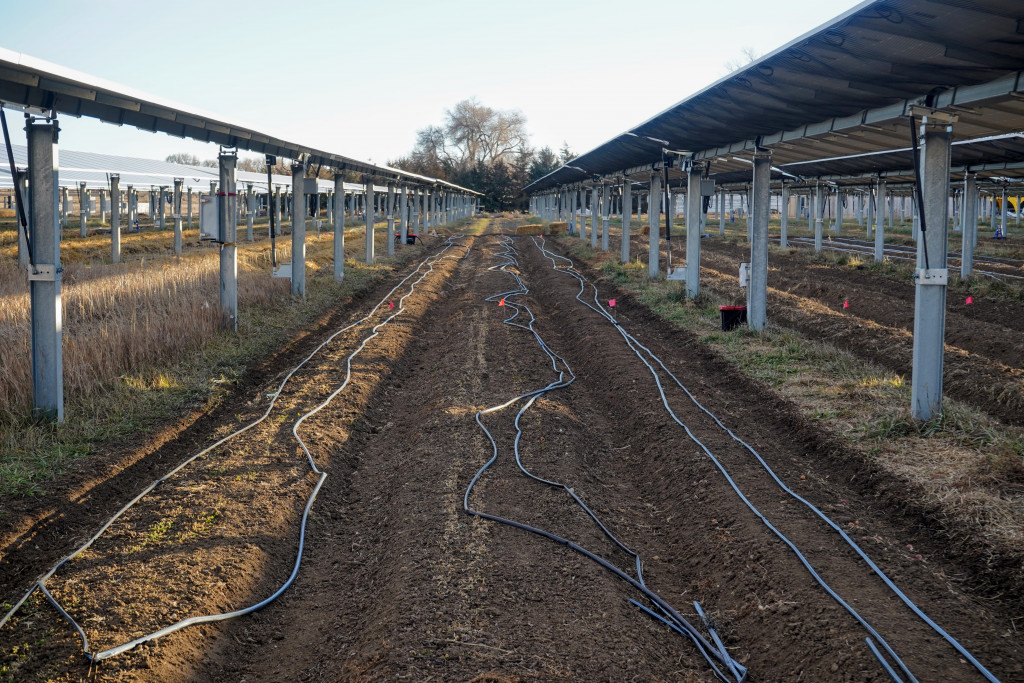
Hay grows under the shade of solar panels at Jack's Solar Garden in Longmont, CO. (Tyler Hickman)

Hay grows under the shade of solar panels at Jack's Solar Garden in Longmont, CO. (Tyler Hickman)
The story was originally published in the Colorado Sun on Jan. 22, 2023.
By Gabe Allen & Tyler Hickman
Once-verdant fields, farms and forests are reduced to gravel lots to make way for utility-scale solar plants at sites around the country. At some, carefully trimmed Kentucky bluegrass is permitted to grow beneath the panels.
But one solar project in Colorado breaks this mold. South of Longmont, just off of Hover Road, savory herbs, sweet berries, veggies and hay flourish between rows of elevated photovoltaic panels. Jack’s Solar Garden is the largest commercially active research facility in the United States for “agrivoltaics,” a land-use model that combines agriculture with solar power.
In just a few acres, the site grows produce for a local farm, produces enough electricity to power 300 homes and hosts researchers from three separate institutions. The project preserves the tradition of the land, which is a third-generation hay operation. At the same time, it is well-positioned for a future in which Colorado’s energy needs are increasingly met by renewable sources.
The idea behind agrivoltaics is simple: Use the “empty” space beneath solar panels to grow stuff. The concept is still young. Agrivoltaic farms and research sites are owned and operated by a few advocates around the country. During this legislative session, however, two Colorado senators plan to introduce a bipartisan bill that could position the state as a leader in agrivoltaics research.
It’s not the first time the topic has been brought to the statehouse. In 2021, Senate Democrats passed Senate Bill 235, providing $3 million of funding for Advancing Colorado’s Renewable Energy and Energy Efficiency program. Of this, a small portion was allocated to purchasing equipment for agrivoltaic operations.
“We’re not the first state to recognize agrivoltaics, but we’re the first state to establish agrivoltaics in statute, and also funding from state funds,” said Sen. Sonya Jaquez Lewis, the bill’s prime sponsor. Jack’s Solar Garden is in her district and after touring the facility, a 10-minute drive from her home, she says she was hooked on the idea of agrivoltaics.
Last year, agrivoltaics appeared at the Capitol once again. Senate Bill 138, sponsored by Denver Democrat Chris Hansen, did not fare as well as its predecessor. Five years of funding for agrivoltaics research was proposed with a hodgepodge of policies intended to reduce greenhouse gas emissions in Colorado. House Republicans mounted a last-second filibuster, killing the legislation.
Bills concerning agrivoltaics have been primarily sponsored by Democrats until now. This year, a Republican lawmaker from Alamosa intends to change that. Sen. Cleave Simpson first became interested in solar agriculture as a potential solution to the challenges that his family faces on alfalfa farm. Years of water scarcity had made the 800-acre operation financially tenuous.
“I was trying to figure out how to make my farm self-sufficient in a lot of respects — energy, soil health and water,” Simpson said. “All of these things kind of come together in this conversation around agrivoltaics.”
Simpson predicts that constituents in his sprawling Southern Colorado district will share his interest in the new technology. Over the past two decades, he has seen neighboring farms and ranches struggle to stay afloat.
“If the next 20 years look like the last 20 years from a water supply perspective, there’s probably 100,000 acres in the valley that doesn’t have an adequate water supply,” he said. “The entire community’s economy, culture and community is built around irrigated agriculture and I just see this freight train coming down the track at it. I’m routinely looking for solutions.”
At its core, agrivoltaics is a marriage of traditional land use with forward-looking infrastructure. Instead of clearing farm fields and pastures to make way for power production, landowners may be able to adapt time-honored agricultural operations to incorporate a second revenue source.
“Economics is certainly the biggest driving factor,” Simpson said. “I wouldn’t want to risk the economic viability of my family farm and my son’s future and my grandson’s future.”
In January, Gov. Jared Polis, a Democrat, reiterated in his annual State of the State address his goal for Colorado to generate 100% of its electricity through renewables by 2040. The goal is part of a broader effort to reduce greenhouse gas emissions in Colorado. Last year, major utilities, including Xcel Energy, submitted clean energy plans to the state that detailed how they would contribute to the transition, including building more renewable energy generation, like wind and solar farms.
Simpson said he sees the writing on the wall. Renewables are expanding in Colorado, and he wants them to benefit farmers when they do.
“If I can be in a space to help drive the conversation and protect ag, I’d much rather be in that space than trying to reverse policy,” Simpson said. “In this position, I have a little more control over what it ends up looking like.”
In the coming legislative session, Simpson plans to introduce a stand-alone bill that creates a grant program for agrivoltaic projects overseen by the newly formed Agriculture Drought and Climate Resilience office. According to a draft, the grants will be available to “new or ongoing demonstration or research project as a means to study the use of agrivoltaics in the state.” It will be the first state law in the country to provide funding for agrivoltaics research, though Massachusetts passed a law funding agrivoltaic generation projects in 2018.
Hansen will co-sponsor the legislation, and some of the language will be reused from Senate Bill 138. They are optimistic the bill will pass this time around.
“Sometimes, with new concepts, people can have some reservations and hesitation,” Simpson said. “If Senator Hansen and I are working on it together, it’ll alleviate potential apprehensions on both sides of the aisle.”

For a farmer, the potential value of an agrivoltaic project is twofold. First, there is solar power itself. The farm can power its own operations or it can generate revenue through a lease agreement from a solar developer. The second potential benefit is harder to quantify.
As the sun moves across the sky, the panels at Jack’s Solar Garden track its course along a single axis. Below them, a shadow moves across the earth and rainwater is deposited along each panel’s downward edge. Before the farm became a solar garden, every square foot received approximately the same amount of sunlight and moisture. Now, the field is broken up into an array of “microclimates.”
This concept is central to the purported benefits of agrivoltaics. Diverse conditions within the same plot of land increase the opportunities to grow diverse crops. In pasture land, agrivoltaic installations might promote more diverse plants, insect pollinators and soil microbiota — essential elements for long-term sustainability.
“For landowners out here, if you can increase productivity at all — great. If you can keep productivity the same — great, because you’re creating energy too,” Colorado State University doctoral student and agrivoltaics researcher Matt Sturchio said. “If you can slightly reduce productivity, but increase biodiversity and also resilience to climate extremes like drought and heat waves — win-win again, right?”
The idea that solar panels might help crops survive drought is a seductive concept in the arid farmlands throughout Colorado and the desert Southwest. Water is always in short supply, and the evidence is mounting that agrivoltaic operations might help. A 2019 study led by University of Arizona researcher Greg Barron-Gafford found that jalapeños and tomatoes used irrigation water more efficiently under the protective shade of photovoltaic panels at a field site outside of Tucson. At Jack’s Solar Garden, partner organization Sprout City Farms grows vegetables, herbs and berries under the shade of panels.
Researchers like Sturchio hope that similar benefits could play out in native grasslands, hay fields and pastures. In addition to shading plants, the panels could provide livestock with refuge from the midday sun.
Soon, a private-sector project will put the theory to the test. In August, Delta County commissioners approved the Garnet Mesa Solar Project, which will pair 80 megawatts of solar capacity with 1,000 local sheep. When completed, it will be more than 60 times larger than Jack’s Solar Garden, taking over the title of the state’s largest agrivolatic facility.

Alexis Pascaris, the founding director of AgriSolar Consulting, has spent countless hours interviewing farmers about their opinions on agrivoltaics. In general, they fall into two camps.
“It’s either ‘Stay off my farmland’ or ‘That’s awesome, how can I leverage those benefits to support my farm and my production?’” she said. The farmers who are interested want to know one thing. “They value social and environmental attributes, but, at the end of the day, it’s got to pencil financially.”
This rationale was at the heart of the impetus for Jack’s Solar Garden. In 2016, Byron Kominek moved onto the family farm after a five-year stint as a U.S. diplomat in Southern Africa. At the time, the farm produced hay. But the margins on the crop were scant compared to when Kominek’s grandfather, Jack, ran the operation in the 1970s and ’80s.
“Haying was interesting, but it didn’t make anything for money,” Kominek said. “And we were getting less and less water every year for irrigating that really thirsty bromegrass.”
When Kominek went to the Boulder County Land Use Department to ask if he could build a solar array on the property, they shot him down. He could run a Christmas tree farm or an equestrian center, but they would not permit him to install solar panels. No matter what was growing underneath the panels, the project was seen as a power plant.
Kominek is an unusually persistent person. Over the course of three years, he convinced county officials to let him build Jack’s Solar Garden and sold shares of the operation to local homeowners. Now, the revenue from the electricity produced on the farm slowly chips away at the bank loan that funded construction, and Kominek has become a prominent advocate on the issue.
To many, Jack’s Solar Garden is a model for what is possible with agrivoltaics. Kominek hopes it is a catalyst for something larger. “Are we just going to keep dinking around with projects the size of mine, or are we actually going to start installing 10 megawatt, 50 megawatt, 100 plus megawatt systems that are aimed at agrivoltaics?” he said.
Other agrivoltaic advocates agree. For Sturchio, state funding is an essential component of applying research to large scale projects.
“I think more state money is important too,” he said, “Because out here, we’re prime for using large range lands or areas that we want to restore.”
Simpson hopes that large-scale agrivoltaics projects might provide an example for farmers including some who are his constituents in the San Luis Valley. “I toured Jack’s Solar Garden last summer and spent time with Byron. It’s pretty impressive to see what he’s accomplished on, from my perspective, a small scale,” he said. “I need to be able to do it on 120 or 160 acres at a time and, you know, do it 50 times, or 100 times.”
Two things stand in the way of grand visions for large-scale agrivoltaic projects. The first is physical. Large-scale renewable energy projects require high-capacity transmission lines. Xcel’s Power Pathway project will bring this type of infrastructure to much of Eastern Colorado over the next few years, but places like the San Luis Valley lag behind.

“The entire supply for the San Luis Valley comes from two lines that generate north of the valley and come over Poncha Pass,” Simpson said.
Valley lawmakers have long discussed a second line into the valley from the east, but no concrete plans are in place to expand transmission infrastructure. For now, new renewable projects are limited by capacity.
Democrats, who control the legislature, don’t have much financial wiggle room beyond their existing funding priorities because the Taxpayer’s Bill of Rights, or TABOR, cap on government growth and spending has not kept up with high inflation rates. Even if Simpson and Hansen’s bill passes, it may not be funded for another year.
“It’s really challenging this year to try to appropriate any dollars for it,” Simpson said. “We can at least get the statutory authority.”
Meanwhile, six Department of Energy-funded projects in other states will test the viability of utility-scale agrivoltaics in various climates and land-use categories. As of now, Jack’s Solar Garden has established Colorado as a leader in the field. If the state wants to maintain that status, it will need to scale up